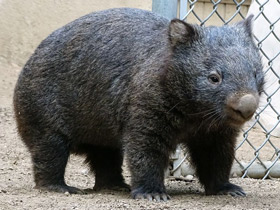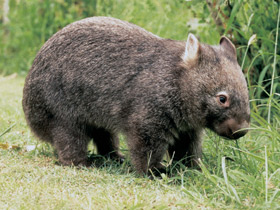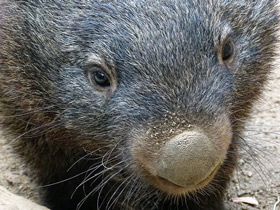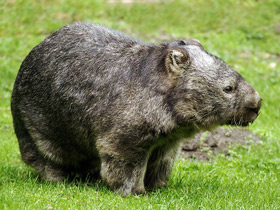The family Vombatidae(Wombats)
The common wombat, the coarse-haired wombat or bare-nosed wombat (Vombatus ursinus)
Wombats are short-legged, muscular quadrupedal marsupials of the family Vombatidae that are native to Australia. Living species are about 1 m (40 in) in length with small, stubby tails and weigh between 20 and 35 kg (44 and 77 lb). They are adaptable and habitat tolerant, and are found in forested, mountainous, and heathland areas of southern and eastern Australia, including Tasmania, as well as an isolated patch of about 300 ha (740 acres) in Epping Forest National Park in central Queensland.
Description
Vombatidae are a family of diprotodontid marsupials, commonly known as wombats. The closest living relative of these wombat species is considered to be the koala, which is noted for being adapted to arboreal life; in comparison, wombats are much less specialised animals in terms of diet and lifestyle.
Vombatidae are burrowing herbivores that resemble small bears. Their body length ranges from 70 to 120 cm and their weight ranges from 20 to 45 kg. The body of the Vombatidae is compact and its limbs are short and strong. Each has five toes, the outer four of which are topped by large claws designed for digging. The tail of Vombatidae is short, the head is large and appears slightly flattened on the sides, and the eyes are small.
Interestingly, the jaws and teeth of Vombatidae are similar in structure to those of rodents. The upper and lower rows of Vombatidae each have a pair of anterior incisor teeth; the chewing teeth are very simply constructed and angular teeth are absent. Vombatidae has the fewest number of teeth among marsupials, with 12.
Habitat
Vombatidae are most common in southern and eastern Australia and include South Australia, Victoria, New Wales, Queensland and Tasmania. They are found in a wide variety of habitats, but require good soil for burrowing. Vombatidae are the largest burrowing mammals today and spend most of their lives underground. With their sharp claws, they dig small habitable caves in the ground, sometimes forming complex tunnel systems. As a rule, most of them are about 20 metres long and 3.5 metres deep. If the areas of individual individuals overlap, the caves can be used at different times by different Vombatidae. Vombatidae are active at night, when they come out in search of food. During the day, they rest in their shelters.
Threats to existence
Adult Vombatidae have almost no natural enemies. One of the few is the introduced human dingo. In addition, the Tasmanian devil (Sarcophilus harrisii) may pose a threat. The hind end of the Vombatidae is extremely tough due to its thick skin, cartilage and bones. In case of danger, they can, by rolling onto their back, block their burrow and repel most attackers, or crush their limbs against the walls of their cave dwelling.
The Vombatidae has a kind of shield on its back, over its pelvic bones, which protects it when attacked from behind. It also gives strong blows with its head, striking like a sheep or a goat. If a dog gets into its burrow, it waits for it by staying in place, and then tries to corner it against the wall of the burrow to strangle it with its shield. It is much more common for humans to be responsible for the death of Vombatidae. In particular, many Vombatidae die under the wheels of cars. In areas where human impact is low, Vombatidae numbers are determined by the availability of suitable food.
Lifestyle and nutrition
The area covered by Vombatidae varies, depending on external conditions, from 5 to 25 ha. The area is marked with droppings and constructed dwellings, and the wombat defends its territory sometimes quite aggressively, sometimes even in fights, in which Vombatidae can cause serious injuries to each other. Vombatidae can reach speeds of up to 40 km/h over short distances.
Vombatidae feed on young shoots of grass. Sometimes they also eat plant roots, mosses, mushrooms and berries. The divided upper lip allows Vombatidae to select very precisely what they eat. Thanks to its front teeth, it can reach down to the ground and cut even the smallest shoots. The sense of smell plays an important role in food selection in nocturnally active Vombatidae.
The metabolism of Vombatidae is very slow but efficient. It takes up to 14 days to digest food. Vombatidae are the most water-saving mammals after the camel: they need only 22 ml of water per kg body weight per day. Even perfectly adapted animals living in Australia, such as kangaroos, use four times their usual amount of water. Vombatidae tolerate cold poorly. Vombatidae have cube-shaped faeces, caused by their distinctive anal opening.
Reproduction
Vombatidae breed throughout the year everywhere, except in arid regions, where breeding is rather seasonal. Females have upside-down pouches to keep dirt out when digging. Although females have two teats, only one young is born and reared at a time.
The young grow in their mother's pouch for six to eight months and remain close for the next year. Vombatidae reach sexual maturity at two years of age. Their lifespan in the wild is up to 15 years, in captivity they sometimes live up to 25 years; the oldest recorded Vombatidae lived up to 34 years in captivity.
The common wombat, the coarse-haired wombat or bare-nosed wombat (Vombatus ursinus)
The common wombat (Vombatus ursinus), also known as the coarse-haired wombat or bare-nosed wombat, is a marsupial, one of three extant species of wombats and the only one in the genus Vombatus. The common wombat grows to an average of 98 cm (39 in) long and a weight of 26 kg (57 lb).
Taxonomy
The common wombat was first described by George Shaw in 1800. There are three extant subspecies:
- Bass Strait (common) wombat (Vombatus ursinus ursinus), the nominate form, was once found throughout the Bass Strait Islands, but is now restricted to Flinders Island to the north of Tasmania, and to Maria Island to the east of Tasmania where it was introduced. Its population was estimated at 74,000 in 2023.
- Hirsute wombat (Vombatus ursinus hirsutus) is found on the Australian mainland.
- Tasmanian wombat (Vombatus ursinus tasmaniensis) is found in Tasmania. It is smaller than Vombatus ursinus hirsutus. Its population was estimated at 840,000 in 2023.
- Hackett's wombat (Vombatus hacketti) is an extinct species of genus Vombatus, inhabiting the southwestern part of Australia. Being around the same size as Vombatus ursinus, with an average weight of 30 kg, Vombatus hacketti went extinct at the end of the Late Pleistocene, in the Quaternary extinction event.
Description and distribution
Vombatus ursinus is a species of diprotodont marsupial in the family Vombatidae, inhabiting Australia, Tasmania and the Bass Strait Islands. It is the only species of its genus.
Vombatus ursinus is 80-130 cm (98 cm on average) long and weighs 17-40 kg (26 kg on average). Wombats living on the mainland (subspecies Vombatus ursinus hirsutum) are larger than those living on the islands.
Vombatus ursinus is distributed in relatively cool and wet areas of southern and eastern Australia, including Tasmania and the mountainous regions of southern Queensland. They are found in a variety of habitats, including tropical and eucalypt forest, alpine meadows and coastal scrub. In some regions, they have adapted to human presence and can be seen grazing in fields with sheep. These clumsy but very handsome animals are covered in thick fur, brown, grey or black in colour. Unlike other marsupials, Vombatus ursinus has only one pair of front teeth, which grow constantly.
Lifestyle and nutrition
Vombatus ursinus lead a solitary lifestyle, and each animal has its own territory in which it lives and feeds. These marsupials have powerful short legs with long claws, adapted for digging burrows. In its territory, the wombat digs an extensive system of tunnels, ranging in length from 2 to 20 metres. It usually has one entrance, but wombats sometimes make a second, smaller entrance for use in emergencies. In hot weather, the wombat may remain outside all day, except in the early morning.
Vombatus ursinus are herbivores; they feed on grains, roots and grasses at night when it is cold. The population of Vombatus ursinus is currently declining, as the animals are often run over by cars. Unfortunately, they often dig their tunnels under fences in rural areas, as they are also harassed by farmers.
Breeding
The breeding season of Vombatus ursinus occurs throughout the year and reaches its peak in winter. Pregnancy lasts 20-30 days and the young spend five months in the pouch, by which time they weigh between 3.5 and 6.5 kg. The mother feeds her young on milk for 12-15 months and they become independent at 18 months of age. Vombatus ursinus reach sexual maturity at two years of age and their average life expectancy in the wild is about 15 years, up to 20 years in captivity.
Threats
Whilst bare-nosed wombats are listed as Least Concern by the IUCN, they remain threatened largely due to anthropomorphic factors including habitat reduction, roadkill and sarcoptic mange. Sarcoptic mange is prevalent in the population and remains the most problematic of issues facing bare-nosed wombats with wildlife carers regularly treating wombats in the field with low-risk moxidectin.
Wombats have also been reported to harbour a range of parasites including ticks and associated pathogens.



















































